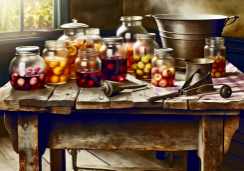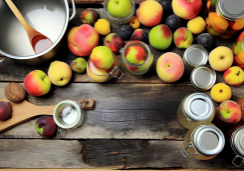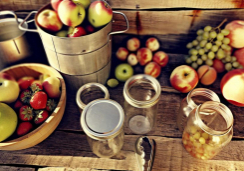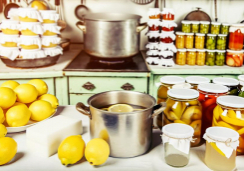Secrets to Perfecting Homemade Pizza Dough
Perfecting pizza dough is a pursuit packed with potential pitfalls, yet when you master the method, the payoff is peerless.
You've likely encountered the common conundrums: crusts that are too tough or toppings that simply slide off a soggy bottom.
It's not just about mixing flour, water, yeast, and salt; it's about understanding how these elements interact.
You must select your ingredients meticulously, manage moisture masterfully, and manipulate your dough with measured motions.
But what if there were subtle secrets that could elevate your efforts from mundane to magnificent?
Imagine serving slices that consistently boast that elusive combination of a crisp base and chewy crumb, with just the right char to send your senses soaring.
Stick with me, and you'll discover that with a few fine adjustments, you can transform your homemade pizza from merely edible to extraordinary.
Selecting Quality Ingredients
To elevate your homemade pizza dough, begin by sourcing high-quality bread flour or Tipo '00' flour, which are pivotal for achieving the perfect texture and rich flavor. Bread flour, with its higher protein content, provides the necessary gluten structure for a chewy, airy crust. Tipo '00' flour, a staple in Italian pizza, offers a finely ground texture ideal for stretching thin and creating a crisp exterior.
Next, you'll need fresh, active dry yeast. This microorganism is the backbone of fermentation, giving your dough volume and the characteristic bubbles that ensure a light, digestible crust. Make sure you're activating the yeast with warm water, which should be between 105°F and 115°F. Too hot and you'll kill the yeast; not warm enough, and it won't activate. Ensure you use enough water to hydrate the flour without making the dough soggy.
Quality ingredients matter deeply for homemade pizza. Opt for filtered or bottled water to avoid impurities that can compromise your dough's flavor. Choose fine sea salt or kosher salt for a perfect balance of seasoning. Lastly, don't overlook the olive oil—a drizzle of high-quality extra virgin olive oil imparts a subtle richness, rounding out the flavor profile of your artisanal creation.
Mastering Dough Hydration
Understanding the hydration level of your pizza dough is crucial for crafting a crust with the ideal chewiness and airiness. Mastering dough hydration isn't merely about mixing water and flour; it's about precision. Your dough needs the right balance to yield that perfect texture.
Begin by selecting the appropriate flour, as its ability to absorb water varies widely.
To achieve the desired hydration, you'll need to experiment. Start with your yeast mixture—using active dry yeast is common. Ensure it's fully dissolved in warm water to activate it effectively. Use a thermometer to check that the water is at the optimal temperature to interact with the yeast. Too hot or too cold, and your dough won't rise properly.
Once the yeast mixture is ready, gradually incorporate it into your flour, allowing the dough to absorb the liquid evenly. Let the dough rest at room temperature; this step is vital for gluten development, which contributes to the dough's structure.
Kneading Techniques Explained
Mastering the art of kneading is essential to transforming your mixture of flour and water into a pizza dough with the perfect texture. When you make this pizza dough, the secret to making it exceptional lies in the kneading process. Here's how to knead with expertise:
- Begin with Pre-shaping: After mixing your ingredients according to your pizza dough recipe, shape the mixture into rough dough balls. Place them in a large bowl and let it sit for a short rest to relax the gluten slightly.
- The Push and Fold Method: Take one dough ball and press it using the heel of your hand to push the dough away from you, then fold it back upon itself. Rotate the dough 90 degrees and repeat. This technique helps to create layers of gluten which are essential for structure.
- Duration and Rhythm: Continue to knead for about 10-15 minutes until the dough is smooth and elastic. A consistent, rhythmic motion is key to developing the dough properly.
- Rest after Kneading: Once kneaded, place the dough back into the bowl, cover it, and let it sit until it doubles in size. This resting period allows the gluten to continue developing, resulting in the perfect texture for your pizza.
Optimal Proofing Practices
Having honed your kneading skills to create a smooth and elastic pizza dough, it's crucial to focus on proofing practices that will ensure the perfect rise. First, make sure you're starting with the right water temperature for proofing yeast—between 110 and 115 degrees Fahrenheit is optimal. This precise heat range is critical for yeast activation, which creates the necessary bubbles in your dough for a successful rise.
Use a thermometer to measure the water temperature accurately. Guesswork won't suffice; precision in this step is non-negotiable. An incorrect temperature can lead to poor yeast activation, compromising the dough's ability to rise properly.
After mixing the dough with the correctly tempered water, cover it with plastic wrap. Let it proof at room temp, which usually encourages a consistent and reliable rise. If the dough has been refrigerated, remember to allow enough time for it to come to room temp before baking. This step is often overlooked, but is essential for the yeast to reactivate after being slowed by the cold.
For best results, dough should proof for several hours at room temp. This duration ensures that the yeast has ample opportunity to work its magic. Don't rush the process; giving your dough enough time to proof will be evident in your pizza's final texture and flavor.
Shaping and Baking Tips
To achieve that quintessential artisanal touch, start by shaping your pizza dough by hand, which allows for a more textured and visually appealing crust. Precision in this step is key. You'll want to:
- Gently spread the dough from the center outward, creating a round base for your toppings. This technique provides an even thickness, crucial for uniform baking.
- Transfer the shaped dough onto a piece of parchment paper atop a pizza peel or an inverted baking sheet. This helps you slide the dough onto a preheated pizza stone, ensuring a crispy bottom.
- Rotate the pizza 180 degrees halfway through the baking process. Set your oven to a scorching 475 degrees Fahrenheit or higher to mimic a professional pizza oven's heat intensity.
- Keep a vigilant eye on your pizza crusts as they bake. The high temperature means the line between perfectly crisp and sadly scorched is thin.
Frequently Asked Questions
What Is the Secret to Great Homemade Pizza Dough?
You'll need precise water temperature, correct flour selection, and fresh yeast. Master kneading, resting, and fermentation times. Add salt and oil carefully, and develop gluten properly. Always dust your surface before shaping the dough.
What Not to Do When Making Pizza Dough?
When making pizza dough, don't overknead or ignore the water's temperature. Use fresh yeast, include salt, and don't rush fermentation. Ensure consistent thickness, don't skimp on oil, and always consider water quality and measurement accuracy.
How to Make Homemade Pizza Dough More Flavorful?
To enhance your pizza dough's flavor, carefully select high-quality flour and ensure the water temperature is ideal for the yeast. Adjust salt proportions, sugar addition, and incorporate olive oil and herb infusions.
How Do You Make Pizza Dough Rise Better?
To make your dough rise better, ensure proper kneading for gluten development and yeast activation. Use a warm environment to aid dough fermentation, control humidity, and allow sufficient rising time to form air pockets.
Conclusion
Now you've got the know-how, it's all about precision and technique. Choose the finest flour, hydrate diligently, knead with purpose, and proof with patience.
Shape your dough with expertise, and bake it on a scorching surface. Remember, restraint with toppings is key to a crisp, delectable crust.
Perfect these practices, and your homemade pizza dough will rival the best pizzerias. Go forth, craft masterfully, and watch your pizza-making prowess become the talk of the town.










